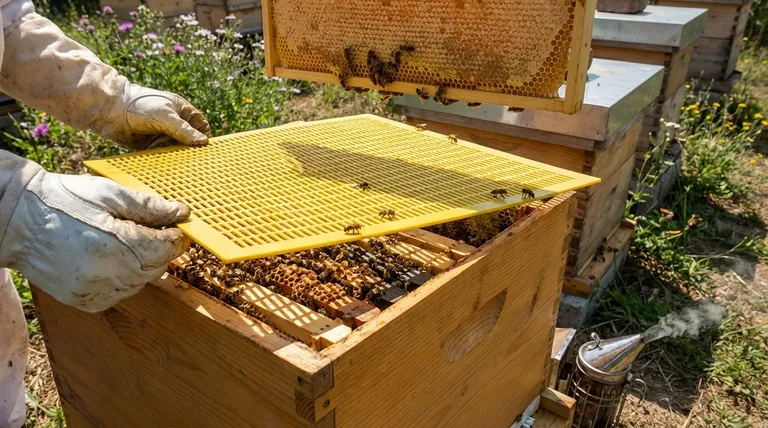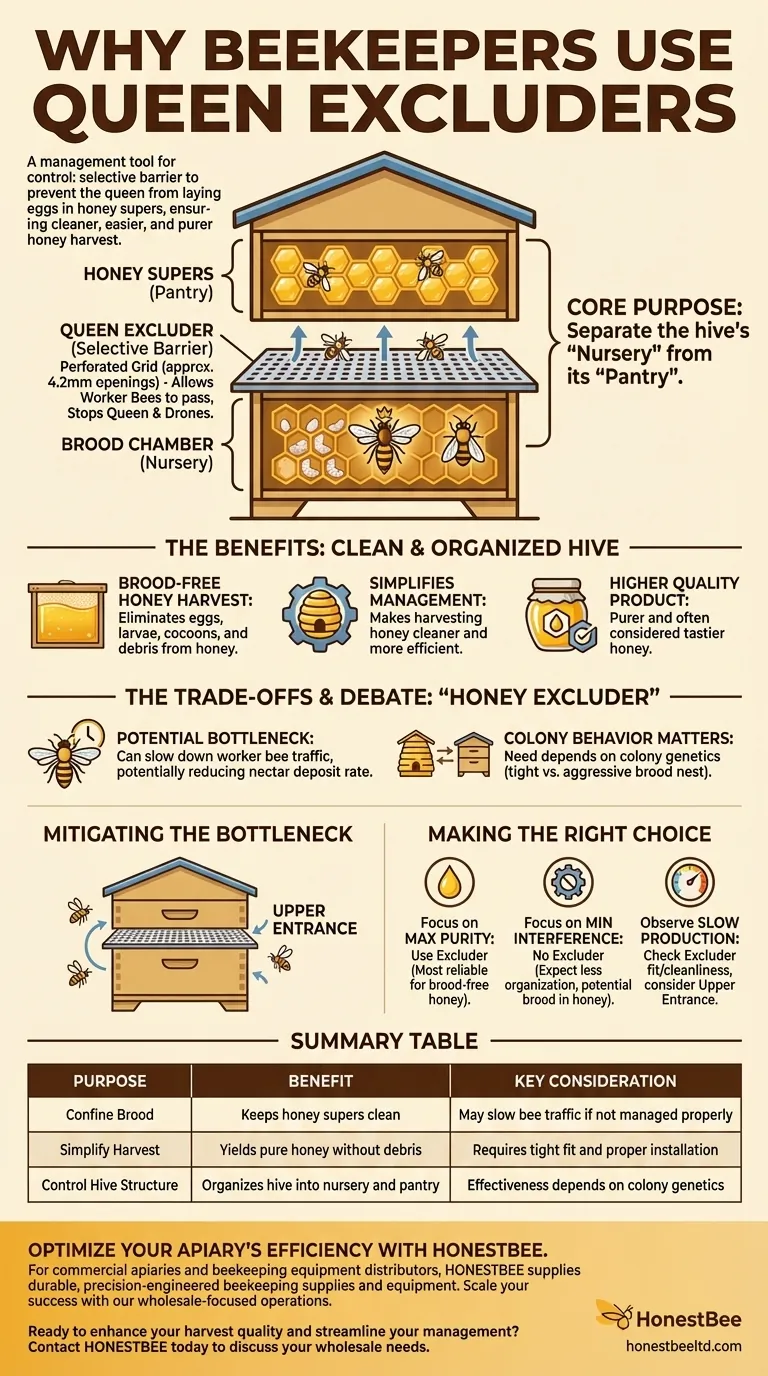At its core, a queen excluder is a management tool for control. Beekeepers use this selective barrier to prevent the larger queen bee from laying eggs in the honey supers—the boxes designated for honey storage. This ensures the honey frames remain dedicated solely to honey, making the harvest cleaner, easier, and yielding a product often considered purer.
The fundamental reason for a queen excluder is to separate the hive’s "nursery" (the brood chamber) from its "pantry" (the honey supers). This simplifies hive management and ensures honey is harvested without the complication of eggs, larvae, or associated debris.

The Core Purpose: A Clean and Organized Hive
A beehive operates as a complex, self-organizing system. The queen excluder is a beekeeper's intervention to impose a specific structure that serves the goal of honey production.
What is a Queen Excluder?
A queen excluder is a perforated grid or screen placed between the hive's brood chamber and the honey supers above it.
The openings, typically spaced 4.2 millimeters apart, are engineered to be large enough for worker bees to pass through but too small for the larger queen and drones.
Containing the Brood Nest
The primary function is to confine the queen to the lower boxes of the hive. This creates a dedicated area for her to lay eggs and raise brood, preventing the brood nest from expanding upward into frames intended for honey.
Ensuring a "Brood-Free" Honey Harvest
When a queen lays eggs in honey frames, the resulting comb contains more than just honey.
As larvae hatch and pupate, they leave behind dark brown postnatal cocoons, shed skins, and bee feces. An excluder prevents this, keeping the honey comb clean.
The Quality Argument
Many beekeepers believe honey harvested from frames that have never contained brood is purer and tastier. By keeping the honey supers pristine, the excluder helps produce a higher quality end product.
Understanding the Trade-offs: The "Honey Excluder" Debate
Despite its benefits, the queen excluder is one of the more debated pieces of beekeeping equipment. Its use is a strategic choice, not a universal requirement.
The Argument Against Excluders
Some beekeepers refer to the device as a "honey excluder," arguing that it can slow down worker bees.
The belief is that the barrier creates a bottleneck, reducing the efficiency with which workers can deposit nectar in the honey supers and thus lowering the overall honey yield.
Colony Behavior Matters
The need for an excluder can depend on the specific genetics and behavior of the colony.
Some queens, particularly from locally bred stock, naturally maintain a tight and compact brood nest. In contrast, other colonies may be more aggressive in expanding the brood area, making an excluder more beneficial.
Proper Use is Non-Negotiable
For an excluder to be effective without overly hindering the bees, it must be used correctly.
It needs to fit tightly with no gaps for the queen to slip through. It must also be kept clean and free of blockages to ensure worker bees can pass freely.
Mitigating the Bottleneck
A common technique to reduce the traffic jam at the excluder is to provide an upper entrance to the hive, located above the excluder. This gives foraging bees a direct route into the honey supers, bypassing the need to travel through the busy brood nest and the excluder itself.
Making the Right Choice for Your Hive
The decision to use a queen excluder depends entirely on your management philosophy and beekeeping goals.
- If your primary focus is maximum honey purity and an easier harvest: Using a queen excluder is the most reliable method for keeping your honey supers completely free of brood.
- If your primary focus is minimizing hive interference and maximizing honey flow: You might operate without an excluder, but be prepared for a less organized hive and the potential for brood in your honey frames.
- If you observe slow honey production after installation: Check that the excluder is clean, properly installed, and consider adding an upper entrance to ease worker bee traffic.
Ultimately, a queen excluder is a powerful tool that, when used thoughtfully, gives the beekeeper precise control over the hive's structure and the final honey product.
Summary Table:
| Purpose | Benefit | Key Consideration |
|---|---|---|
| Confine Brood | Keeps honey supers clean and dedicated to storage | May slow bee traffic if not managed properly |
| Simplify Harvest | Yields pure honey without eggs or larval debris | Requires a tight fit and proper installation |
| Control Hive Structure | Organizes the hive into nursery and pantry areas | Effectiveness depends on colony genetics and behavior |
Optimize Your Apiary's Efficiency with HONESTBEE
For commercial apiaries and beekeeping equipment distributors, efficient hive management is key to profitability. A queen excluder is just one tool in a well-equipped operation. HONESTBEE supplies the durable, precision-engineered beekeeping supplies and equipment you need to scale your success.
We understand the demands of large-scale honey production. Our wholesale-focused operations ensure you get the reliable gear your business depends on, from excluders to full hive systems.
Ready to enhance your harvest quality and streamline your management? Contact HONESTBEE today to discuss your wholesale needs and discover how our equipment can support your commercial goals.
Visual Guide

Related Products
- Professional Plastic Queen Excluder for Modern Beekeeping
- Premium Wood Framed Metal Wire Queen Bee Excluder
- High Performance Plastic Queen Excluder for Beekeeping and Apiary Management
- Plastic Queen Bee Excluder for Bee Hive Wholesale
- Wooden Queen Bee Excluder for Beekeeping
People Also Ask
- What is the purpose of a queen excluder when adding a super? Streamline Your Honey Harvest
- What is the primary function of a queen excluder in beekeeping? Control Hive Layout for Efficient Honey Harvesting
- How do queen excluders work in terms of spacing and bee movement? A Guide to Precision Hive Management
- How does a queen excluder work? Master Hive Management for Pure Honey Harvests
- What are the main advantages of using a queen excluder in beekeeping? Simplify Hive Management & Harvest



















